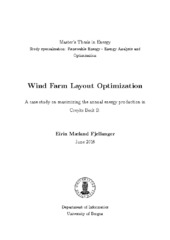| dc.description.abstract | For offshore wind farms, detailed planning, including wind farm design optimization, is becoming increasingly important to secure and increase the wind farm's revenue during its operational life time. Since the energy production represents the wind farm's only economical income, optimizing layouts with the objective of maximizing the annual energy production, can cause a significant increase in profitability for various projects. Motivated by this, the optimization tool TOPFARM, is applied on the planned wind farm Crekye Beck B, to generate optimal layout suggestions with respect to attained annual energy production. TOPFARM is considered a powerful tool for wind farm optimization, but is mainly developed to handle small test cases. Considering the size of the wind farm, the focus in the thesis is thus divided into two parts. The fist part focuses on enabling TOPFARM to run for the required number of turbines, which is handled by developing various implementations. The second part focuses on attaining improved solutions by applying TOPFARM, using three approaches to layout optimization, developed in the thesis. The first approach is constructed to perform optimizations based on three different sets of constraints, for turbine relocation. The second approach is to perform optimizations on various fractions of the available area, and to evaluate the optimal area utilization. The third approach is to optimize the layout by calculating the energy production in the optimization with a higher resolution of included wind speeds and wind directions, than for the other approaches. Based on the results obtained from the various approaches, it is concluded that a further development of TOPFARM is recommended with respect to handling large wind farm cases, in order to attain improved solutions. It is also found, that utilizing only a fraction of the available area might be more profitable, which can reduce expenses with respect to both installation and maintenance. | en_US |
